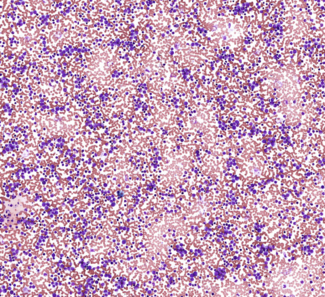20. CML-CP smear: Difference between revisions
No edit summary |
No edit summary |
||
| Line 1: | Line 1: | ||
[[File:CML - overview.png|thumb|Much higher WBC/RBC ratio than normal| | [[File:CML - overview.png|thumb|Much higher WBC/RBC ratio than normal|325x325px]]'''Staining''': May Grunwald-Giemsa | ||
'''Organ''': Blood smear | '''Organ''': Blood smear | ||
| Line 13: | Line 13: | ||
* Philadelphia chromosome (t(9;22)) | * Philadelphia chromosome (t(9;22)) | ||
'''Theory''':[[File:CML - mature and immature cells.png|thumb|Mature and immature cells| | '''Theory''':[[File:CML - mature and immature cells.png|thumb|Mature and immature cells|331x331px]]''The CML slide I have is different than the one in class, so there’s no point in an overview picture. The characteristics are the same anyway''. | ||
CML involves an extreme proliferation of the myeloid cell line, which includes those cell lines that develop from myeloblasts into basophils, eosinophils and neutrophils (not monocytes). Because of this can we see many immature WBCs in the peripheral blood smear. These immature cells are large, have small cytoplasm and large nuclei. | CML involves an extreme proliferation of the myeloid cell line, which includes those cell lines that develop from myeloblasts into basophils, eosinophils and neutrophils (not monocytes). Because of this can we see many immature WBCs in the peripheral blood smear. These immature cells are large, have small cytoplasm and large nuclei. | ||
Latest revision as of 13:50, 7 July 2024

Staining: May Grunwald-Giemsa
Organ: Blood smear
Description:
There is a marked increase in the number of WBCs compared to normal. Not only mature cells are visible (neutrophils, basophils, eosinophils), but also immature cells.
Diagnosis: Chronic phase of chronic myeloid leukaemia
Causes:
- Philadelphia chromosome (t(9;22))
Theory:

The CML slide I have is different than the one in class, so there’s no point in an overview picture. The characteristics are the same anyway.
CML involves an extreme proliferation of the myeloid cell line, which includes those cell lines that develop from myeloblasts into basophils, eosinophils and neutrophils (not monocytes). Because of this can we see many immature WBCs in the peripheral blood smear. These immature cells are large, have small cytoplasm and large nuclei.
The cell types you must recognize are mature neutrophils (segmented nucleus) and immature cells.
